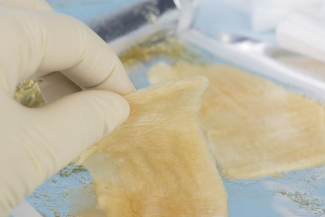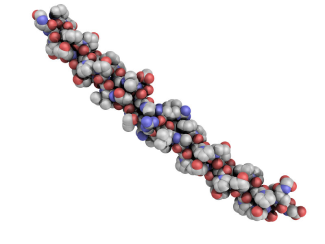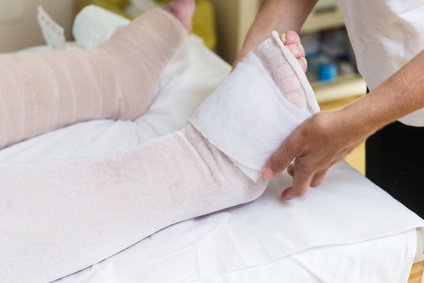Wound Dressing Options for Achieving Moisture Balance
August 11, 2021
Selection of a wound dressing requires a multifaceted approach. Currently, no dressing can meet all needs of a wound (infection prevention, promotion of re-epithelialization, moisture balance, etc.).1 Clinicians must weigh the benefits and drawbacks of the dressing or dressings chosen, to optimize wound healing. However, one aspect that is common to most wound dressings is the need for moisture balance to promote wound healing. To achieve this balance, an appropriate dressing must be chosen. To aid in the clinical reasoning process, this discussion contains a breakdown of the dressings that research indicates are most effective for maintaining a wound’s moisture balance.
Alginate Wound Dressings
Alginates are non-adhesive pads and ribbons composed of natural polysaccharide fibers or xerogel.
Benefits. After absorption of exudate, alginates form a moist environment. Alginates are easy to pack, can be applied over irregularly shaped wounds, and are generally comfortable for the patient.2 Indications. Alginates are indicated for wounds with large amounts of exudate. These wounds may include:
- Pressure injuries
- Diabetic foot ulcers
- Cavity wounds
- Venous leg ulcers
- Post-operative wounds
- Traumatic wounds
- Partial-thickness burns
Contraindications. Alginates must have exudate to absorb to promote proper moisture balance. They should not be used on dry wounds, over eschar, on third-degrees burns, or on surgical wounds. They are also contraindicated for wounds with anaerobic infections.3
Other Factors to Consider. Alginates often require a secondary dressing because they do not have adhesive properties. To optimize moisture balance, the secondary dressing may also act as a barrier to absorb excess fluid that the alginate cannot absorb.
Collagen Wound Dressings
Collagen wound dressings come in a variety of forms and contain collagen derived from animal sources. Collagen dressings encourage the deposition of new collagen fibers, support granulation tissue formation and new tissue growth, and ultimately support a moist wound healing environment.
Benefits. Collagen dressings encourage the deposition of new collagen fibers and support granulation tissue formation and new tissue growth. As collagen absorbs exudate, it helps create and maintain a moist environment directly on the surface of the wound bed, and it helps to maintain the hemodynamic stability of the wound bed. Collagen is biodegradable and fully utilized in the wound bed; therefore, there is no need for its removal from the wound surface during dressing changes.4
Indications. Collagen wound dressings are indicated for the following wound types:
- Abrasions
- Full-thickness and partial-thickness wounds
- Dehisced surgical wounds
- Donor sites and other bleeding surface wounds
- Pressure injuries
- Diabetic foot ulcers
- Ulcers caused by mixed vascular etiologies
- Traumatic wounds healing by secondary intention4
Contraindications. Collagen wound dressings should not be used on the following wound types:
- Third-degree burns with dry eschar
- Wounds with dry eschar
- Wounds with active vasculitis
- Wounds with sensitivity to collagen or silver4
Other Factors to Consider. Collagen wound dressings require a secondary dressing and are a cost-effective means of promoting moist wound healing in wound management.4
Foam Wound Dressings
Foam dressings are made of semipermeable, small, open cell polyurethane. They contain foamed polymer solutions and are capable of holding fluids. The level of absorption depends on the material and the thickness, as well as the number of layers and the types of materials making up those layers.
Benefits. The primary functions of foam dressings include:
- Absorption of wound exudate
- Maintenance of a moist wound healing environment
- Insulation of the wound to maintain a constant temperature to facilitate cell division and migration
- Control of biofilm development (foams with antimicrobial properties)
- Use in infected or non-infected wounds
- Use as a primary dressing on shallow wounds and as a secondary dressing on deeper wounds
- Skin protection on top of bony prominences or high-friction areas on the skin
Indications. Foam dressings may be indicated for any wound with excessive exudate.5 These wounds may include:
- Diabetic foot ulcers
- Venous leg ulcers
- Pressure injuries
- Chronic wounds
- Surgically dehisced wounds
Foam dressings may also be indicated for:
- Skin tears
- Skin grafts and donor sites
- Venous ulcers (in combination with compression therapy)3
Contraindications. Foam dressings are contraindicated on third-degree burns, necrotic tissue, or wounds without drainage. Non-silicone foam dressings should be used carefully on or near fragile skin.3
Other Factors to Consider. Foam dressings do not need to be changed frequently because they are highly absorbent and can remain in place up to seven days. Of note, foam dressings with silver or other antimicrobials may reduce the overall cost of wound care.6
Gelling Fiber Wound Dressings
Gelling fiber dressings control exudate levels to reduce the risk of periwound maceration while maintaining a moist wound healing environment.
Benefits. Gelling fibers aid in moisture balance by managing drainage. They also promote a slow level of autolysis7 by helping remove necrotic, damaged, or infected tissue from a wound. This promotes a slow level of autolysis.7 As exudate is absorbed into the dressing, it forms a soft gel, while encapsulating the wound in a healthier, moist environment promoting the formation of granulation tissue. Although gelling fiber dressings conform to the terrain of various wound shapes, they can also be removed in one piece without damaging new granulation tissue.
Indications. Gelling fiber dressings are indicated for wounds with moderate to excessive exudate, as well as aiding in the removal of dead, damaged, or infected tissue from the wound. They are also available with antimicrobial properties, most often silver, to aid in addressing biofilm control and for use with infected wounds.
Contraindications. Gelling fiber dressings should not be used on dry wounds. If used with lower levels of exudate, gelling fiber dressings should be saturated with saline before application, and if needed they must be soaked with a saline solution before removal to reduce the risk of wound damage.
Other Factors to Consider. Gelling fiber dressings have been found to be the most cost-effective for post-operative wounds after total hip or knee arthroplasty.3
Hydrocolloid Wound Dressings
Hydrocolloid wound dressings are advanced wound care dressings composed of gelatin, pectin, or carboxymethylcellulose. They are available in the form of wafers, powders, or pastes. The wafer forms are waterproof and self-adhering, and this makes them easy to use, while they are maintaining a moist wound healing environment conducive to granulation tissue formation.
Benefits. Hydrocolloid dressings facilitate granulation tissue formation, inhibit bacterial growth through an acidic environment, and promote autolytic debridement. Indications. Hydrocolloids are indicated for the following wound types:
- Wounds with light to moderate exudate
- Partial- and full-thickness wounds
- Pressure injuries
- Minor burns and abrasions
- Leg ulcers
- Burns
- Donor sites
They can also be indicated as a protective measure against shearing forces and pressure injury development3 on bony prominences.
Contraindications. Hydrocolloids should be avoided in wounds with high levels of exudate, dry wounds, infected wounds, and diabetic foot ulcers because of growth of anaerobic bacteria.3 They also should not be used after hypergranulation has occurred.
Other Factors to Consider. Hydrocolloid dressings have been found to be the most cost-effective type of dressing for pressure injuries.6 They can be used in high-friction areas because they adhere well to intact tissue. Additionally, hydrocolloid dressings can help to reduce pain.3 Hydrocolloid dressings should not be removed with a vertical pull; instead, loosen the edge and pull horizontally, and the dressing will release easily from the skin. This technique helps to reduce the risk of skin tears with the dressing’s removal in patients with fragile skin.
Hydrogel Wound Dressings
Hydrogels are designed to provide moisture and rehydrate a dry wound bed. Hydrogels come in three main forms: amorphous, impregnated, and sheets.
- Amorphous hydrogel: viscous form. It comes in tubes, foil packages, or spray bottles.
- Impregnated hydrogel: hydrogel-saturated gauze pad, nonwoven spongy ropes or strips.
- Sheet hydrogel: hydrogel that is held together by a thin fiber mesh. This type of hydrogel wound dressing is available with and without the adhesive borders.
Also, all are available in antimicrobial versions, with silver being the most widely used antimicrobial additive. Hydrogel dressings are 90% water- or glycerin-based, and the other 10% consists of three-dimensional networks of hydrophilic polymers. These dressings are designed to maintain optimum moisture level in he wound bed (some have the ability to absorb small amounts of exudate). This provides an ideal environment for proper and easier wound cleaning and pain management. As a result, the formation of necrotic tissues can be decreased, so that the healing process may progress in timely fashion to closure.
Benefits. Hydrogels offer moisture to a dry wound. This high moisture content is beneficial in:
- Providing a barrier to potentially infectious microorganisms
- Providing antibacterial enzymes in some versions
- Having a soothing or cooling effect on the wound bed
- Especially in patients with severe wounds or if the patient has other health issues, such as diabetes
- Cooling effect can last up to six hours
- Facilitating autolytic debridement3
- Promoting ease of removal and less pain with dressing changes because they do not adhere to the wound bed
- Wounds that are very dry or necrotic wounds, such as superficial abrasions, severe scrapes, and scratches. Hydrogel helps improve this type of wound because it provides sufficient hydration that helps with skin moisture retention and effective healing. If the wound site is overdrying, it is possible for scabs to form excessively, delaying the entire healing.
- Partial or full-thickness lesions. Because hydrogel dressing does not stick or allow the necrotic tissue to slough off during the healing process, it promotes faster healing process.
- Minor burns. Although minor, burns almost always cause excruciating pain and tenderness to the skin. Hydrogels are helpful for minor burns in that they have a soothing effect on the wound site.
- Wounds that create cavities or depressions in the skin. Hydrogels are fibrous and contain glycerin, which promotes faster cell regeneration. Applying the gel for depressed wounds is likely to improve tissue growth and minimize the risk of a dented healed wound site.
Indications. Hydrogels can be indicated for the following wound types:
- Wounds with minimal exudate or necrotic tissue
- Help improve healing by providing adequate hydration and moisture retention
- Do not allow scabs to form, which could delay healing
- Dehydrated wounds
- Partial- or full-thickness wounds (superficial abrasions, scrapes, scratches)
- Do not stick or allow the formation of necrotic tissue or slough during the healing process
- Lacerations
- Exposed tendon or bone
- Minor burns (including those from radiation therapy), by supporting faster healing as well as having a cooling soothing effect on the burn
- Wounds resulting in cavities or depressions in the skin
- Along with the polymers, hydrogels also contain glycerin and both promote faster granulation tissue formation and epithelialization
- Chickenpox lesions, by softening the scab and soothing the area
- Donor sites
- Pressure injuries
Contraindications. Hydrogel dressings should not be used on wounds with heavy exudate or in sinus tracts. Also important is that hydrogel dressings may cause an allergic reaction. In areas at high risk for cross contamination or infection, such as sacral or coccygeal wounds, hydrogels do not provide an adequate bacterial barrier for the wound that other dressings may offer.
Other Factors to Consider. Hydrogel dressings require changing every three days. Therefore, proper follow up care must be available. Hydrogels can be easily removed by irrigating with a saline solution before removal.3
Choosing the Best Dressing
The literature has shown that no single wound dressing type will meet the needs of every wound.1 However, each dressing has unique properties that can help create an optimal moisture balance and promote healing. Using this guide, clinicians can decide on a case-by-case basis which wound dressing is best, following best practices while also being cost-effective.
The views and opinions expressed in this blog are solely those of the author, and do not represent the views of WoundSource, HMP Global, its affiliates, or subsidiary companies.












Follow WoundSource
Tweets by WoundSource